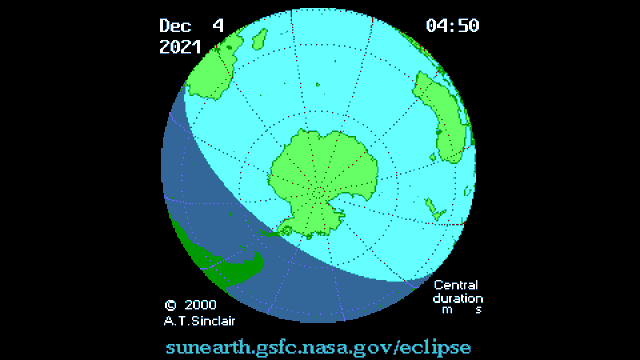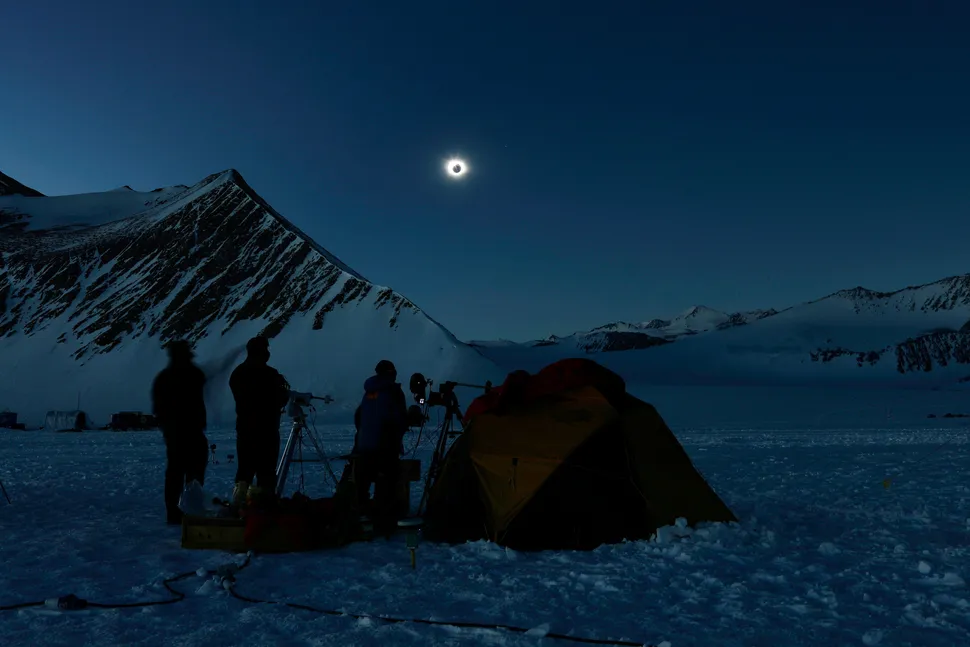Solar eclipse in Antárctida 2021
credits: Felipe Trueba/Imagen Chile/AFP via Getty Images
via Space.com
Um momento muito aguardado pela comunidade científica. E o resultado são imagens impressionantes. Um eclipse solar total mergulhou a Antárctida na escuridão.
Tratou-se de um raro fenómeno astronómico a que apenas alguns cientistas e entusiastas com elevado poder económico assistiram.
Para que o eclipse seja total, quando a Lua passa entre o Sol e a Terra, os três têm de estar directamente alinhados. Um fenómeno raro que custou mais de 35 mil euros aos entusiastas que quiseram estar presentes para assistir ao vivo.
Esta animação da NASA mostra o caminho percorrido pelo eclipse solar total de 4 de Dezembro de 2021 na Antárctica.
Começou no extremo sul do Oceano Atlântico, moveu-se através da Antárctica para terminar no oceano do outro lado, como pode ser visto na faixa delineada em azul.
Alguns navios de cruzeiro transportando astrónomos esperaram ter vislumbres do eclipse solar total no oceano.
Turistas em luxuosos navios de cruzeiro que atravessaram as águas gélidas, ou em voos especialmente programados para assistir ao fenómeno, juntamente com cientistas conseguiram presenciar esse momento incrível.
Western Antarctica was plunged into momentary darkness during a total solar eclipse. Antarctica experiences continual daylight from mid-October until early April but the eclipse brought a few minutes of total darkness. The eclipse was partially visible from South Africa, Chile, New Zealand, and Australia.
Last Saturday, December 4, 2021, the moon passed in front of the sun in the only total solar eclipse of the year.
It was a dazzling sight, but one visible to only a few. The path of totality for the solar eclipse, a thin strip in which the moon's shadow touches the Earth's surface, stretched across a remote part of Antarctica where relatively few human observers could see.
A partial eclipse was visible to parts of Saint Helena, Namibia, Lesotho, South Africa, South Georgia and Sandwich Islands, Crozet Islands, Falkland Islands, Chile, New Zealand, and Australia.
Solar eclipses happen when the new moon passes in front of the face of the sun, from Earth's perspective.
Attention ! Never look at the sun directly with your eyes; instead, follow the safety guide we have later in this article to help you.
Still, intrepid scientists ventured out into the harsh Antarctica terrain to observe the solar eclipse (and broadcast it live).
In the first photo (above), taken by photographer Felipe Trueba for Imagen Chile, AFP and Getty, a small team of Chilean and U.S. scientists observe the solar eclipse at totality from Union Glacier in Antarctica.
This second photo of the total solar eclipse of 2021 from photographer Felipe Trueba from Union Glacier in Antarctica shows a land awash in darkness during the moment of totality.
The totality phase lasted about 2 minutes, precious time in which scientists snapped photos of the moon and sun for studies on both objects, as well as the effects of such eclipses on Earth.
During a solar eclipse, the outer region of the sun's atmosphere, called the corona, can be observed by scientists in a rare opportunity to study the region. It is typically obscured by the bright face of the sun, NASA has said.
How would we be there! Amazing!
Geração 'explorer'
05.12.2021
sources:
Space.com




No comments:
Post a Comment